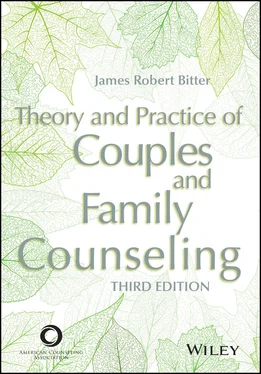James Robert Bitter - Theory and Practice of Couples and Family Counseling
Здесь есть возможность читать онлайн «James Robert Bitter - Theory and Practice of Couples and Family Counseling» — ознакомительный отрывок электронной книги совершенно бесплатно, а после прочтения отрывка купить полную версию. В некоторых случаях можно слушать аудио, скачать через торрент в формате fb2 и присутствует краткое содержание. Жанр: unrecognised, на английском языке. Описание произведения, (предисловие) а так же отзывы посетителей доступны на портале библиотеки ЛибКат.
- Название:Theory and Practice of Couples and Family Counseling
- Автор:
- Жанр:
- Год:неизвестен
- ISBN:нет данных
- Рейтинг книги:5 / 5. Голосов: 1
-
Избранное:Добавить в избранное
- Отзывы:
-
Ваша оценка:
- 100
- 1
- 2
- 3
- 4
- 5
Theory and Practice of Couples and Family Counseling: краткое содержание, описание и аннотация
Предлагаем к чтению аннотацию, описание, краткое содержание или предисловие (зависит от того, что написал сам автор книги «Theory and Practice of Couples and Family Counseling»). Если вы не нашли необходимую информацию о книге — напишите в комментариях, мы постараемся отыскать её.
Theory and Practice of Couples and Family Counseling — читать онлайн ознакомительный отрывок
Ниже представлен текст книги, разбитый по страницам. Система сохранения места последней прочитанной страницы, позволяет с удобством читать онлайн бесплатно книгу «Theory and Practice of Couples and Family Counseling», без необходимости каждый раз заново искать на чём Вы остановились. Поставьте закладку, и сможете в любой момент перейти на страницу, на которой закончили чтение.
Интервал:
Закладка:
So I would highly recommend that before you ever counsel your first couple or family—and just before you meet every other couple or family you will ever see—you start by centering yourself, by becoming present. To be worth something to others, you have to start with your own self-worth. Take a moment to breathe and to release yourself from distress and distractions. Appreciate who you are and who you are becoming. Allow yourself to have access to all of your senses and to use them appropriately: What will you see when you walk in the room? What will you hear? What are you feeling? When you extend your hand in greeting and receive the hands of others, how will you experience this touch? What messages do you want your touch to send, and what messages are you open to receiving? Smell and taste will probably be least useful in meeting a person or family, but on occasion even these senses can help you be more fully present.
As you meet the members of a family for the first time, be aware of any stress you may feel in your body. This is often a first clue that the exercise of hanging hats is necessary. Ask yourself: What pictures come to mind, what traits in others stand out, what do you think people attend to in you, what first impressions are involved, and what third-party information do you have? Is any of this getting in your way? What will help to clear your heart and mind? What will help you set projections, introjections, and outside information aside for the time being and allow you to meet the people right in front of you?
Being present is the first step in making contact and in engaging a family. Both presence and contact happen in the here and now. They are facilitated by a decision to be aware of self, others, and the context in which you are meeting. Family practitioners remove themselves from good contact when they ask distracting questions, such as “How am I doing?” or “What will others think of my work?” or “Can I do this right?” Our first questions ought to be the following: Who am I meeting at this moment in time? What do these people want to convey to me about their thoughts, feelings, and behaviors? What interests me about them? Indeed, what fascinates me about them? What do I need to do to welcome them, create some safety, and validate the effort it took for everyone to get to the session? Although presence and contact are essential to a therapeutic relationship, other personal and professional attributes also contribute to successful family practice— and we consider these next.
Personal Characteristics and Orientations of Effective Family Practitioners
In this section, I describe the values, traits, attributes, characteristics, and orientations that are commonly associated with effective family counseling. No one has all of the characteristics mentioned here. There is also no ideal combination of characteristics, because in reality a wide range of people and personalities have become very successful family practitioners. If you are just starting in the field, however, it may be useful to consider the following attributes and their importance to you as a person and to your work as a facilitator of family growth and development.
Presence. Of all the qualities listed here, none is more important than the ability to be present in counseling sessions. To be present is to focus on clients with interest and even fascination, which means bringing all of our senses to bear in meeting the people with whom we will work.
Acceptance, interest, and caring. Human beings spend most of their lives in systems and institutions permeated with criticism and authoritarian structures. Effective family practitioners position themselves as antidotes to such negative experiences and situations. They seek to replace critical, negative judgments with understanding, reframing, acceptance, and encouragement. They set a tone from the very first session that allows anything to be expressed and to be heard with interest.
Assertiveness and confidence. Although there is no specific personality type that a family practitioner must be, it is difficult to imagine a shy or reticent person achieving any measure of success. Especially when families include young children and teenagers, family counseling requires a certain degree of assertiveness. Assertiveness is related to confidence. It is speaking in a clear, even voice and communicating without defensiveness. It includes setting boundaries in the service of psychological freedom. It is being comfortable as a leader of the process without taking over for the family itself.
Courage and risk. Courage is usually the foundation for assertiveness and confidence. Courage walks hand in hand with respect. It starts with faith in oneself as well as the processes involved in family practice. Courage frees family practitioners to listen and allows them to stay calm and relaxed while observing family dynamics and interactions. There is always a risk in any new therapeutic relationship; family counseling involves taking reasonable risks in the service of better or preferred lives.
Adaptability (openness to change). Family counseling rarely progresses in a linear fashion. Families move forward and then fall back; they take in, but they also block. Family systems are like any living organism: They require constant adaptation within the process of change. Effective family practitioners come to expect the ebbs and flows of therapeutic process. Adapting to the needs of the situation is not just an option in family counseling: It is a necessity.
Listening teleologically. Teleology is the study of final causes, an intended future, or purposes and goals. Both human beings and families intend the future. Everything that people do is in the service of some envisioned end or goal. Knowing the goals and desired outcomes of a person or a family directly impacts the process of therapy. As Satir and Baldwin (1983) noted, every complaint also contains a hope: This is the basis for reframing, which we consider in later chapters.Adlerians are perhaps the most teleologically oriented (Carlson & Englar-Carlson, 2017; Carlson et al., 2006; O. C. Christensen, 2004). They tend to transform all problem statements into interactions by asking, “When was the last time this problem occurred? How did it go?” It is in the interaction that Adlerians discover the goals, motives, and purposes that individuals and families intend with their behaviors.
Working in patterns and holism. Patterns occur across the human experience. Both individuals and families establish patterns to organize their lives and bring a certain level of consistency and predictability to what they do. To understand individuals and families is to understand the patterns that they have chosen to enact. Holism is an understanding of human patterns and processes within the social contexts that support them (Smuts, 1926/1996). Individuals grow and function within family systems, and family systems exist within communities and cultures that are further influenced by nations and even global considerations. Getting to know people and their families requires a very wide focus that includes an assessment of the impact that larger systems play in the lives of clients.
Appreciating the influence of diversity. Most of us grow up in a given part of the world in a certain community within a family that has influencing, if unrecognized, cultures and a socioeconomic status. We absorb both the attributes and the evaluations of the life situations in which we grow up. Slowly we come to recognize that other people in other parts of the world are different from us. Family practitioners, like other members of the helping professions, realize that tolerating differences is not enough; today’s counselors need to be sensitive to and actually understand and appreciate differences in social class, race, ethnicity, creed, gender, health and ability, and sexual and affectional orientation and to bring this understanding and appreciation right into the middle of their work.
Читать дальшеИнтервал:
Закладка:
Похожие книги на «Theory and Practice of Couples and Family Counseling»
Представляем Вашему вниманию похожие книги на «Theory and Practice of Couples and Family Counseling» списком для выбора. Мы отобрали схожую по названию и смыслу литературу в надежде предоставить читателям больше вариантов отыскать новые, интересные, ещё непрочитанные произведения.
Обсуждение, отзывы о книге «Theory and Practice of Couples and Family Counseling» и просто собственные мнения читателей. Оставьте ваши комментарии, напишите, что Вы думаете о произведении, его смысле или главных героях. Укажите что конкретно понравилось, а что нет, и почему Вы так считаете.












